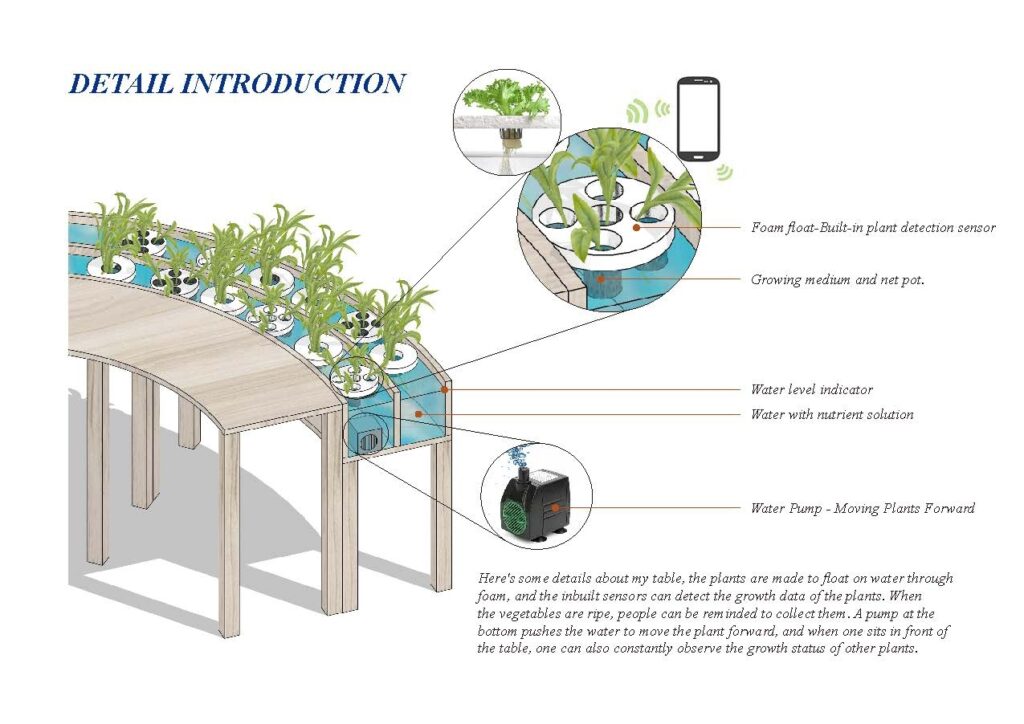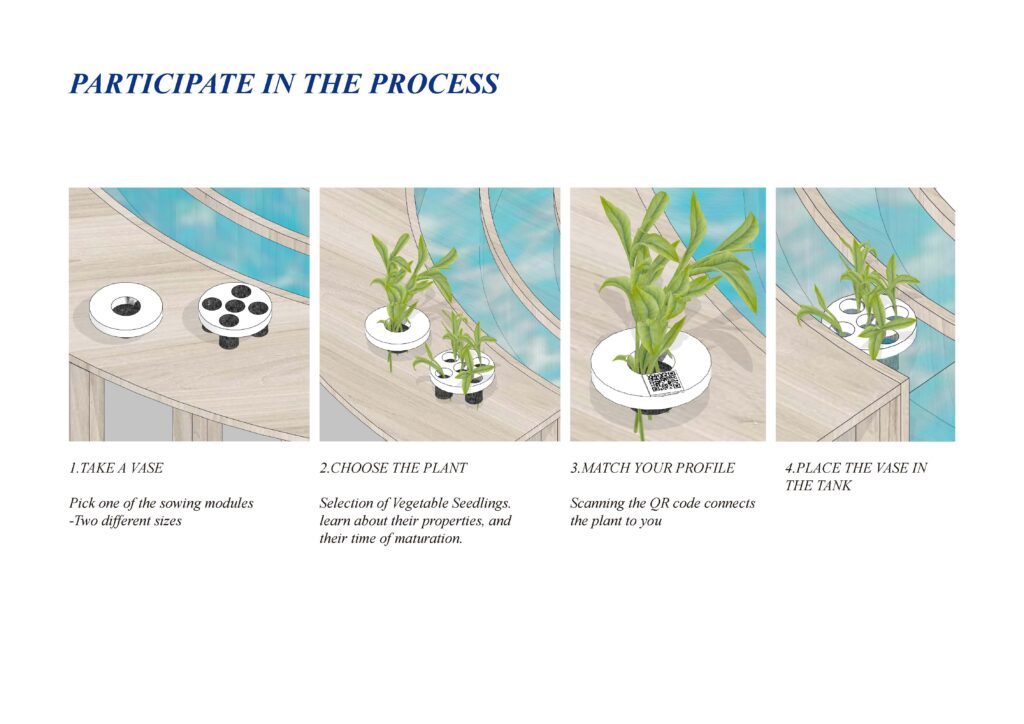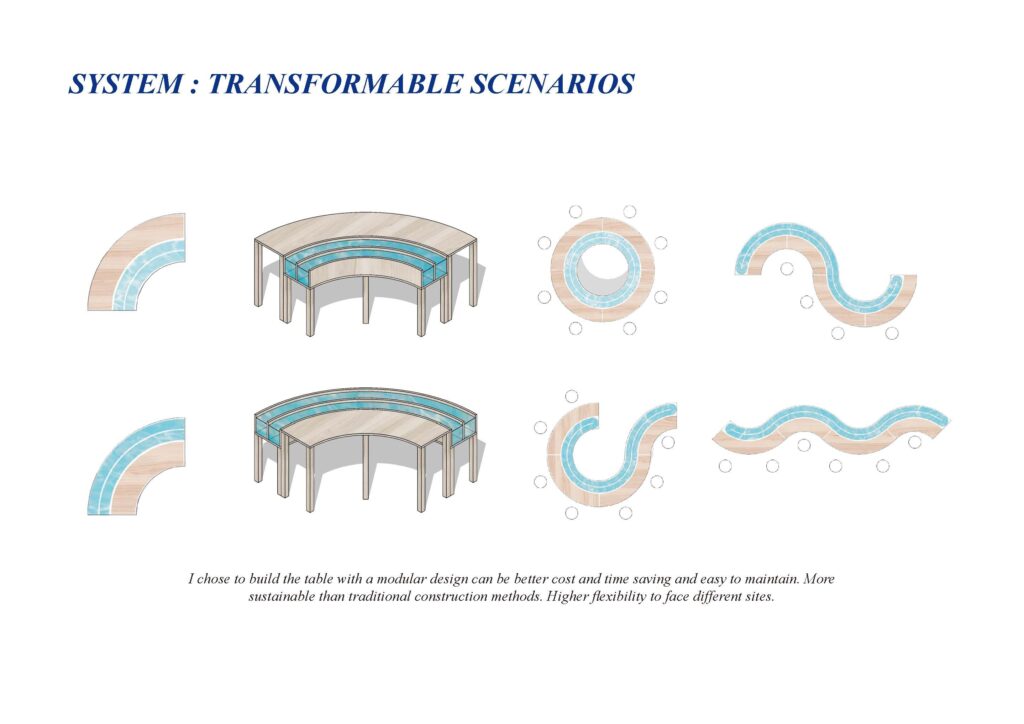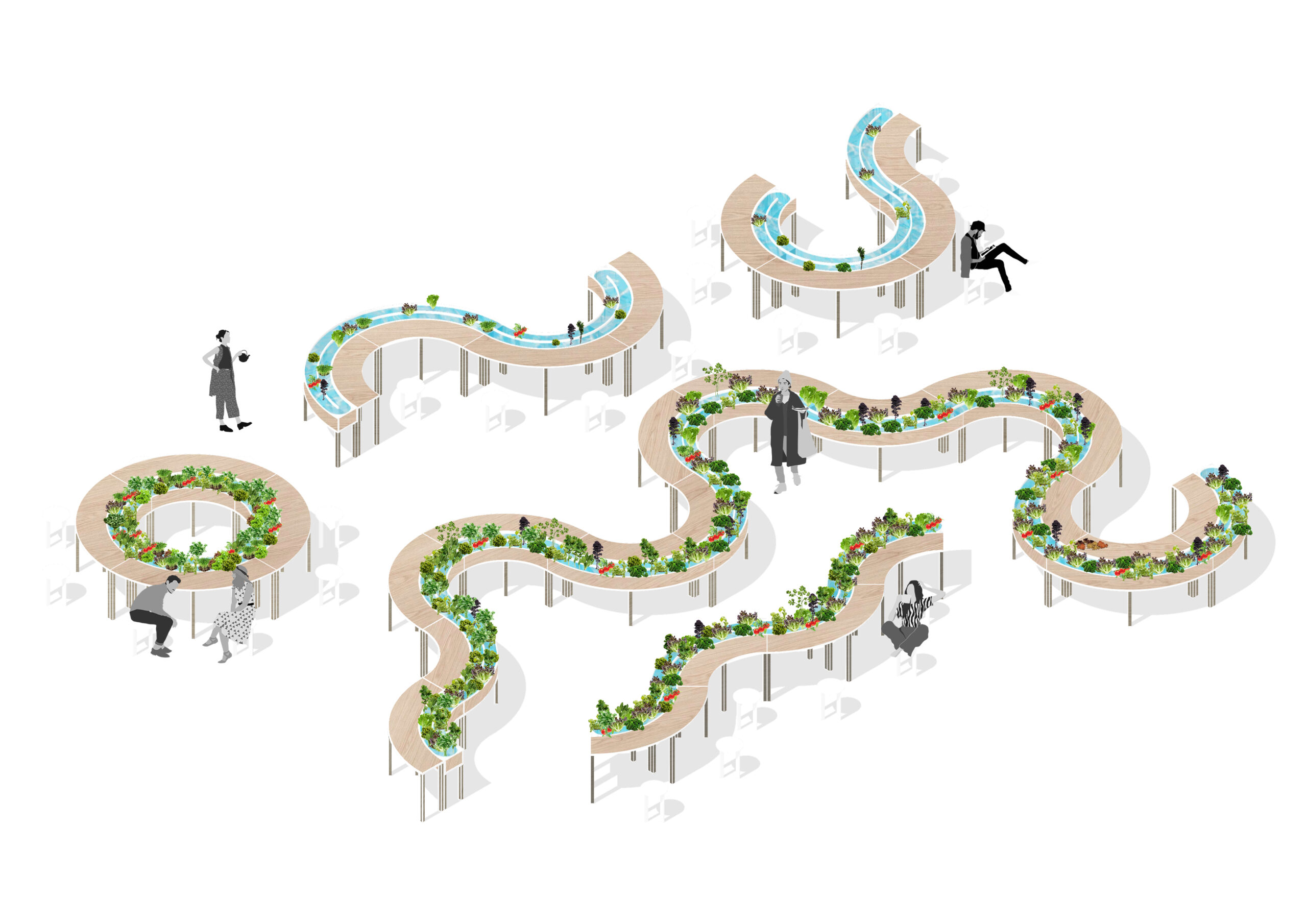An artist is crafting edible Landscapes in the Heart of the City
Basil, parsley, and mint sprouts, nestled in small foam vases, gently sway along the water channel cut into a curved wooden table. Framed by green moss and flanked by rustic tableware, the setup blends natural charm with elegant simplicity. Currently being showcased within the MA Design exhibition at Goldsmiths University, Huyang Liu (Leo), the artist from China, who is behind the idea was consistently present, greeting every visitor with a cheerful explanation of his grand vision.
In Leo’s blueprint, his installation finds its place in the communal areas of office buildings or adjacent outdoor spaces. Envisioned as a sanctuary within the hustle of daily work, it invites hurried lunch-goers to pause. “Instead of rushing to buy a salad or sandwich,” he says, “why not pick it fresh, craft it yourself, and share it right here? I call it ‘Farm to Fork.’
Farm to Fork is more than a space; it’s a concept urging people to reconnect over freshly harvested meals, right at the heart of urban bustle.
“Growing up, I’ve moved back and forth between city and country, always feeling more at peace in the countryside,” Leo says. His time there was filled with outdoor adventures, “We’d spend our days barefoot, fishing in the river behind our houses, catching shrimps or sneaking fruits from the neighbours’ orchard.”

Photograph: Provided by Huyang Liu (Leo)
This idyllic simplicity is what he aims to recapture and share through his design. “I want to bring that genuine rural experience, that connection to nature, back into urban lives, including my own,” he says.
What began as a nostalgic sentiment quickly expanded into a response to a larger urban crisis – food waste. Volunteering at The Felix Project food bank, Leo encountered the harsh reality of hunger among London’s abundance, exacerbated by striking food wastage.
Talking to lots of people about the disconnection, he came to realise that the alienation of people from the food they consume and its origin is a fundamental issue in fostering a lack of appreciation and, consequently, increased wastage. We’ve seen these issues magnified in the advent of Covid-19, during which the vulnerabilities of our urban food supply chains and the indispensable value of self-sufficiency were laid bare.
Leo set out to create a large farm for urbanites “to really dive into that feeling of wide-open fields and bridge that gap.” says.
However, after visiting several city farms in London, he recognised a major issue: the commute to these often remotely located or even centrally placed farms just wasn’t practical for those with busy lifestyles. “Even for research, spending two hours in transit every day proved to be too much,” he says.
So, instead of going into nature, Leo considered how he could bring nature closer.

Photograph: Provided by Huyang Liu (Leo)
“I started thinking if I could use places like a parking lot, a rooftop or just a square for an installation,” says Leo, contemplating innovative ways to make nature accessible right where people live and work.
In redesigning traditional agriculture, Leo adopted DWC hydroponics, a tech-savvy choice enhancing plant growth in water without soil, informed by his exploration of cutting-edge farming techniques. He highlights this approach as both advanced and eco-friendly, simplifying maintenance. This innovation positions “Farm to Fork” as a glimpse into the future of agriculture, advocating for a shift towards sustainable urban farming practices.
“I’ve designed an adoption sequence,” Leo says as he picks up the seeds and foam vases on display: select a vase, pick vegetable seedlings, scan the QR code to connect the plant to yourself, understand their growth and maturation, plant them following instructions, and finally, place the vase in the circulating water tank. “It’s just like adopting an ‘electronic pet’.”
He hopes this interactive process will clarify the journey of food from seed to table, rebuilding a tangible emotional connection to what we eat that naturally reduces waste.
The idea of a water channel beside a dining area for the plant pots to float, is inspired by the ancient Chinese tradition of “Qu Shui Liu Shang,” a poetic Tang Dynasty game where cups of wine would meander down a stream, challenging poets to compose verses wherever the cups came to rest. It’s a beautiful concept in which you are asked to pause to engage with your surroundings and ponder life. And Leo’s modern interpretation is a serene call to observe nature’s ebb and flow, just like the poets of old.

Photograph: Provided by Huyang Liu (Leo)
Leo sees “Farm to Fork” as more than an agricultural initiative; it’s a nexus for community bonding. The space, the foraging or the “pet” adoptions, act as an icebreaker, encouraging new friendships around shared interests. He hopes to attract local horticulture enthusiasts to share their knowledge, thereby enriching the community fabric. It offers a dual chance: to delve into plant care and to form connections with those nearby, either through active participation or the simple enjoyment the greenery brings.
Adopters don’t need to worry about taking care of the plants. The species selected for the “Farm to Fork” installations are notably resilient and easy to maintain. Herbs like basil and mint, along with leafy greens such as butter lettuce and kale, all adapt quickly to hydroponic systems and thrive with minimal effort. Additionally, professional oversight is arranged, with monthly checks by volunteers. This low-maintenance approach has been proven viable through three experimental phases, during which the plants have successfully thrived.
The exhibition showcased a segment of the “Farm to Fork” setup, which is designed to be modular. “It’s like Lego,” Leo explains, “You take a module and piece it together in whatever way you like.” With each unit priced at approximately three to four hundred pounds, costs could decrease in bulk. The versatile modules fit various layouts and spaces, such as round tables, wavy patterns, or curved structures, all demonstrated at the exhibit with physical models, showcasing the adaptability and scalability of his concept for city farming.

Photograph: Provided by Huyang Liu (Leo)
Leo is currently entering competitions in an effort to secure funding that would allow for the practical realisation of “Farm to Fork” on a larger scale.
He is also actively refining his design to make it more accessible and engaging for a wider audience. He’s exploring the integration of red and blue light fixtures to enhance early plant growth and shorten growth cycles. Committed to environmental principles, he’s planning future enhancements to ensure the materials used are fully recyclable and biodegradable, aligning with sustainable practices.
Regardless of the challenges, Leo is determined to keep pushing his concept forward: “Because I genuinely like this project, I plan to continue pursuing it, even if there may not be much support.”
